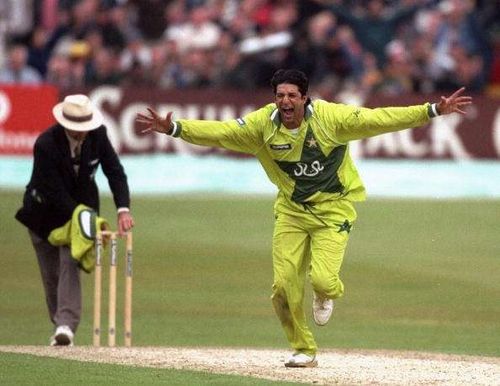
Cricket’s X-Factor – The Left Arm Pace Bowler

Ever since Wasim Akram broke into the cricketing scene, there haven’t been many sights more fascinating than watching the left arm fast bowler making the batsmen hop. Like the elegance of left-handed batsmen, there is something delightfully esoteric about the left-arm fast bowler. They add variety to a skipper’s repertoire and almost always translate into wickets, thanks largely to the discomfort they cause to batsmen.
With T20 cricket gaining in popularity and helping in revolutionizing the way ODI cricket is played too, more and more teams are rummaging their fast-bowling closets to look for left-arm fast bowlers who can provide much-needed variety to the bowling arsenal. A great example is the way India brought back Ashish Nehra into the thick of things ahead of genuine fast bowlers like Umesh Yadav and Varun Aaron, seeking experience, swing and most importantly, variety in the way the ball is delivered and boy, has he delivered.
Left-arm pacers in ODIs
Two of the top three pace bowling wicket-takers in ODIs over the last two years are left-armers. The reserves that teams have in the left-arm pace bowling department have skyrocketed in the last few years. The world’s best ODI bowler is a left-arm paceman.
Mitchell Starc of Australia is tied with Trent Boult of New Zealand for most wickets in ODIs over the last two years. Starc boasts of a better average and economy, but Boult has 53 wickets, same as the Australian in just 24 matches, 3 fewer than that of Starc.

Wahab Riaz of Pakistan, who’ll be remembered for his fiery spell against Australia in the 2015 ODI World Cup Quarter-Final is third, with 46 wickets in 30 games. His fellow countryman Mohammad Irfan, known for his uncomfortable bounce is fourth with 42 wickets in 32 games.
All these four bowlers are much sought-after even in the T20 format, whether it is international or domestic T20 cricket. Another name that has cropped up over the last year is that of Bangladesh’s Mustafizur Rahman, who has picked up a stunning 26 wickets in 9 games with an average of 12.34 including three five-wicket hauls.
England has unearthed two in Topley and David Willey, while New Zealand also have Mitchell McClenaghan.
Left-arm pacers in T20
In T20 cricket, any variety is good news for the team. Mohammad Amir’s stunning spell against India in the recently concluded Asia Cup is a classic example of the havoc the fast left-arm bowler can wreak. Amir, since his re-inclusion into active cricket following a five-year ban, has picked up 8 wickets in 7 matches. Wayne Parnell hasn’t played much in the last one year but still leads the pack in the last 2 years with 15 wickets in 11 matches.
Boult boasts of a great average with 13 wickets in 8 matches. But it is his fellow countryman, McClenaghan, who boasts of the most T20 appearances by a left-arm fast bowler in the last 2 years, with 13 matches and 14 wickets, after a resurgence that started in the IPL, playing for the Mumbai Indians.
Nehra, since his surprise call to the international T20 team in the absence of Mohammad Shami, hasn’t bowled badly either picking up 13 wickets in 10 matches featuring in three successive victorious campaigns. Wahab Riaz also has 13 wickets, the same as Bangladesh’s Mustafizur.
Another surprise entrant in the top 10 is Oman’s Bilal Khan with 14 wickets in 9 matches in the last couple of years. Starc has slipped down the list in the last 1 year, largely because of his injuries and focus on Test cricket but Faulkner still provides Australia with the much-needed variety.
Advantages

There are many advantages offered by the left-arm pace bowler. The footmarks they create are a great factor in Tests and a little insignificant in the T20 format, but on a crumbling wicket with loose surface, that is still a plus in the 50 over format. However, the bigger advantage of playing a left-arm pace bowler is the uncomfortable, back-into-the-pads, in-swinging delivery to the right-hander that has earned bowlers like Wasim Akram many a wicket in their heyday.
Starc’s lethal yorkers, Boult’s swing and Irfan’s disconcerting bounce into the rib-cage are all extra vicious because of the angle that is created by the left-arm paceman.
In T20 cricket, the left-arm paceman, besides extracting any swing that is available, can also change the angle and hustle up the batsman especially when they are out on the attack in the power-play overs. Nehra’s and Amir’s success in the power-play overs is a classic example of that.
Just like the right-hand and left-hand batting combination unsettles bowlers, the left-arm and right-arm pace bowling combination is a tough act for the batsman to get acclimatised to, especially in 20 over format. Bowlers like Nehra, who have a slinging action, make things tougher.
Conclusion
As short format cricket evolves at the rate of knots, teams are desperately trying to pack as much variety into their attack as possible. While batting by its very nature cannot be expanded beyond the classical right and left-hand combination, there is scope for experimentation diversification in bowling.
Like mystery spinners, left-arm pace bowlers are precious commodities in modern day cricket, especially if they can bowl full at will and swing the ball in when there is movement in the air. A battle well begun is half-won in cricket and a steaming left-arm fast bowler can ensure that in the first 6 power-play overs in T20 cricket and prove the adage time and time again!